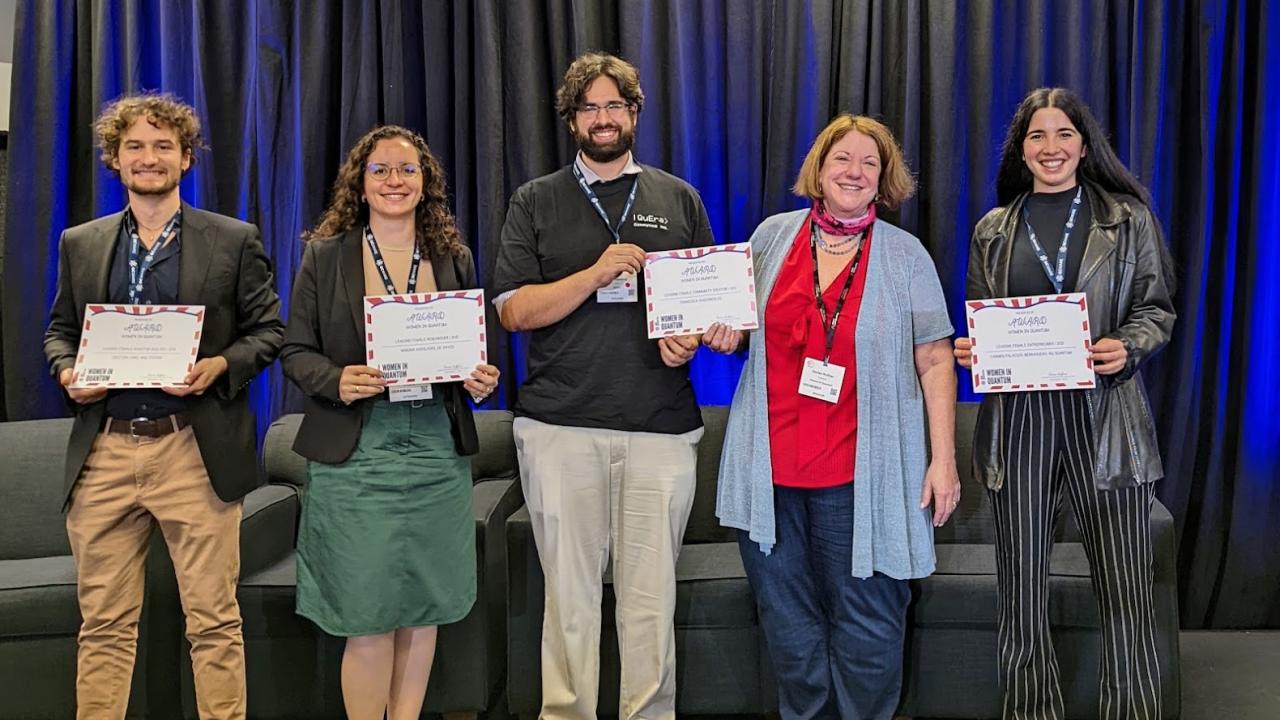
ECE professor Marina Radulaski recognized with a Women in Quantum - Leading Female Researcher award by OneQuantum
Quick Summary
- Radulaski leads the R-Lab on the UCD campus, focused on developing quantum nanophotonic devices for the quantum internet
UC Davis electrical and computer engineering (ECE) professor Marina Radulaski earned a OneQuantum award from QuEra Computing. Presented at a ceremony on December 7 at the Q2B conference in Santa Clara, the OneQuantum awards recognize “those who have made outstanding contributions to the advancement of global quantum technology.”
The Q2B conference brings together the world's leaders in quantum technology research. It is presented annually by QC Ware, a startup developing quantum algorithms to run on quantum hardware. Their customers have included Airbus and Goldman Sachs as well as aerospace, energy and life sciences firms.
Radulaski leads the R-Lab at UC Davis, which is developing quantum nanophotonic devices to help realize the quantum internet, a theoretical future system of interconnected devices sharing information via quantum signals rather than radio waves. For the quantum internet to work, information between quantum systems needs to travel via individual particles of light, photons, in an optical fiber.
“What we’re doing with light here is similar to what a supercomputer does with current,” she says.
Light is used as a medium to carry information because it can travel for long distances before disintegrating. For the light and information to stay coherent, though, the quantum computer needs to stay cool and isolated from disturbances.
“We celebrate it when it’s isolated for just milliseconds and we aim to expand this time frame in the future,” she says.
Even when protected from disturbances, photons can travel along a fiber for only about 50 miles before getting absorbed, making long-distance communications a challenge. To address this, the R-lab builds quantum repeaters, devices that help photons to travel farther.
“Semiconductors with luminescing defects, such as silicon carbide and diamond, are candidates for this technology due to their unique optical and magnetic properties,” she explained. “Our team at the R-Lab develops photonic devices that exploit these favorable properties for the development of quantum repeaters.”
They take crystals, embed color centers—places where some of the carbon is replaced with other atoms and colored light can be refracted—then nanofabricate photonic devices on top of the crystal. They prefer to have solid-state devices integrated onto a chip because they make devices much easier to ship, as opposed to having ionic particles that have to be shipped with lasers.
Radulaski also teaches quantum information technologies and quantum computing courses at UC Davis, with the help of IBM quantum computers.
“I find it pretty special to be a part of ECE’s vision in building a quantum computing curriculum. We are proud to see students who have taken the course continue to do research in the field, win quantum hackathons, get offers for competitive graduate programs and take quantum technology jobs,” she said.
In 2022, Radulaski and the R-Lab will expand their state-of-the-art spectroscopy setups, which have new quantum detectors that will allow them to precisely characterize color centers in silicon carbide. Different types of color centers have different properties, and those that can refract infrared light work best for long-distance communication as infrared gets absorbed less. They are also developing new nanofabrication techniques at the UC Davis Center for Nano-Micro Manufacturing and at the Berkeley Lab’s Molecular Foundry to better build new photonic devices for quantum hardware.
They are also developing a model of an analog photonic quantum simulator and pushing the limits of quantum modeling on classical computers.
“This is a huge project we put together for the pandemic, where students could work from home on a theoretical quantum system with many color centers,” she said. “The students are about to release a paper on their work and we’re all proud of them.”
Finally, in their newest and Radulaski’s favorite line of research, they are using quantum computers to aid the design of photonic hardware.
Although she’s aware of the current limitations of quantum computing technology, Radulaski is extremely optimistic about the future of the field.
“I think quantum computing is going to generate exciting breakthroughs, though it is hard to predict in which specific area,” she said. “Ten years ago we were only dreaming of having quantum computers, and today we are playing with them from the classroom. Our progress depends on how many young people we can motivate to join this growing field and become experts that will set new directions of research and development.”